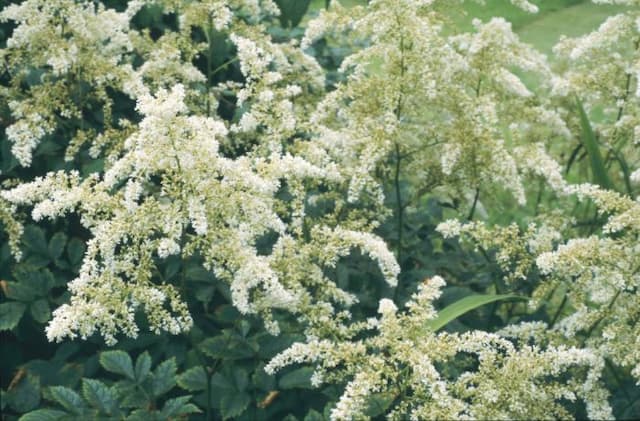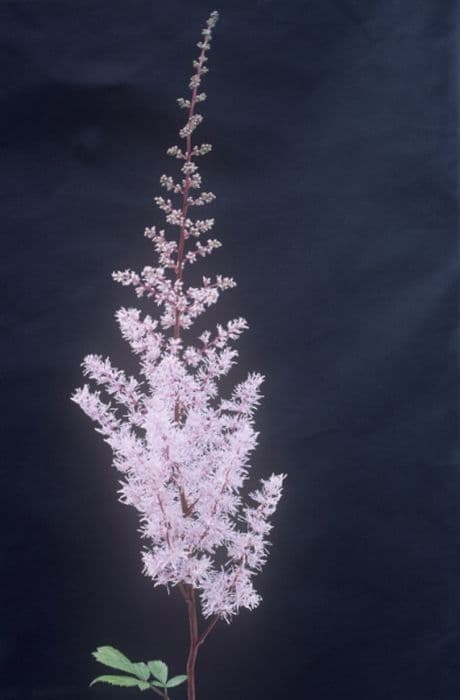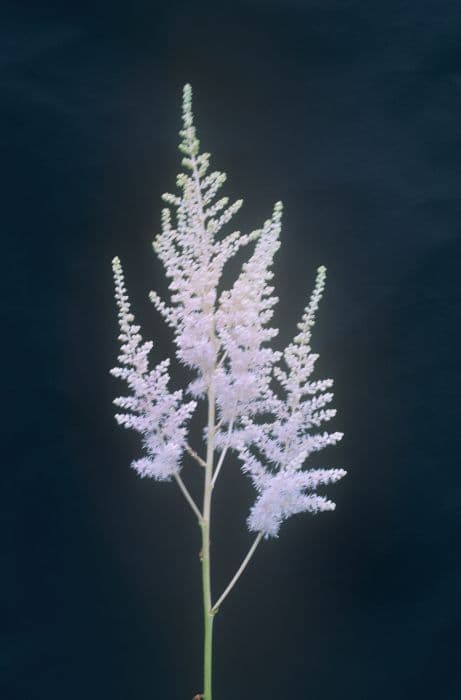Fortune saxifrage 'White Fantasia' Saxifraga fortunei var. obtusocuneata 'White Fantasia' (5)

ABOUT
A compact, herbaceous perennial growing to 10cm tall and 25cm across. A profusion of white flowers are borne above the fleshy green leaves in late summer to early autumn
About this plant
 Names
NamesFamily
Saxifragaceae
Synonyms
Fortune's Saxifrage, Fortune Saxifrage
Common names
Saxifraga fortunei var. obtusocuneata 'White Fantasia'
 Characteristics
CharacteristicsLife cycle
Perennials
Foliage type
Deciduous
Color of leaves
Green
Flower color
White
Height
1 foot (0.3 meters)
Spread
1 foot (0.3 meters)
Plant type
Herb
Hardiness zones
Varies
Native area
Asia
Benefits
 General Benefits
General Benefits- Aesthetic Appeal: Saxifraga 'White Fantasia' has delicate white blooms that enhance the visual appeal of gardens and landscapes.
- Low Maintenance: This variety is known for being low maintenance, requiring minimal care once established.
- Ground Cover: Its growth habit makes it an excellent ground cover, reducing soil erosion and suppressing weeds.
- Seasonal Interest: With its late flowering season, it provides interest in the garden during the fall.
- Tolerance to Shade: 'White Fantasia' is shade-tolerant, making it suitable for planting in parts of the garden that receive less sunlight.
- Attracts Pollinators: The flowers can attract bees and other pollinators, supporting local ecosystems.
 Medical Properties
Medical PropertiesThis plant is not used for medical purposes.
 Air-purifying Qualities
Air-purifying QualitiesThis plant is not specifically known for air purifying qualities.
 Other Uses
Other Uses- Photography: The striking appearance of 'White Fantasia' with its delicate flowers can be used as a subject for botanical photography or as a backdrop for macro photography.
- Creative Arts: Artists may use the shape and form of the leaves and blooms as inspiration for botanical drawings, paintings, or prints.
- Ice Cream Flavoring: The subtle taste of the petals can be infused into creams, providing a unique flavoring for gourmet and artisanal ice creams.
- Cake Decoration: Petals of Saxifraga can be candied and used to decorate cakes or desserts, providing an edible and ornamental touch.
- Craft Projects: Dried petals can be incorporated into paper making or used in potpourri mixtures for a gentle, natural fragrance.
- Textile Patterns: The plant’s floral design can inspire patterns used in textile design for fabrics, scarves, or other fashion items.
- Educational Tool: It can serve as a learning subject for lessons in horticulture or botany courses focusing on diverse plant species.
- Garden Themes: The variety can be utilized in garden designs that center around a white color theme or fairy-tale-inspired gardens.
- Special Occasions: Due to its elegant appearance, the plant can be used in table arrangements for weddings or other special events.
- Garden Sculpture Integration: The plant can complement garden sculptures when planted around them, adding a soft aesthetic to hard landscapes.
Interesting Facts
 Feng Shui
Feng ShuiThe Saxifrage is not used in Feng Shui practice.
 Zodiac Sign Compitability
Zodiac Sign CompitabilityThe Saxifrage is not used in astrology practice.
 Plant Symbolism
Plant Symbolism- Persistence: The Saxifraga genus is known for its ability to grow in rocky crevices and harsh conditions, representing the ability to thrive against all odds.
- Tenacity: The common name "Saxifrage" comes from Latin, meaning "stone breaker," symbolizing determination and strength to break through tough barriers.
- Protection: Often found in alpine regions, Saxifragas embody the concept of sheltering smaller plants by breaking the wind and providing shade, leading to the symbolic association with protection.
- Enduring Love: With its delicate blossoms that reappear year after year, Saxifraga can symbolize lasting affections and the enduring nature of love.
- Adaptability: The Saxifraga's ability to adapt to various environments and conditions mirrors the human characteristic of versatility and resilience in the face of change.
 Water
WaterWater the Japanese Saxifrage 'White Fantasia' deeply yet infrequently, aiming to maintain consistent moisture without waterlogging the soil. During active growth in spring and summer, water when the top inch of soil feels dry, approximately once a week, using about a gallon per plant. Decrease watering frequency in fall and winter to every two weeks or less, depending on the ambient humidity and temperature, since growth slows and the plant requires less moisture.
 Light
LightThe Japanese Saxifrage 'White Fantasia' thrives in bright, indirect light or partial shade, making it ideal for an east-facing garden where it can receive morning sunlight. Avoid direct, harsh afternoon sun which can scorch the leaves. A spot under a tree that provides dappled sunlight, or a position with filtered light throughout the day, would be perfect.
 Temperature
TemperatureJapanese Saxifrage 'White Fantasia' prefers cooler temperatures with ideal conditions ranging between 50°F and 70°F. The plant can endure brief periods of colder weather down to about 30°F but should be protected from frost. Similarly, it will suffer if exposed to prolonged temperatures above 80°F, so it should be shaded during the hottest parts of the year.
 Pruning
PruningPrune Japanese Saxifrage 'White Fantasia' to remove any dead or damaged foliage as necessary to maintain plant health and appearance. This light pruning can be done at any time of year. More substantial pruning should be done in early spring to shape the plant and encourage bushier growth.
 Cleaning
CleaningAs needed
 Soil
SoilFortune's Saxifrage 'White Fantasia' thrives in well-draining, humus-rich soil with a slightly acidic to neutral pH between 6.0 and 7.0. A mixture containing peat, perlite, and pine bark suits it well, providing both aeration and moisture retention.
 Repotting
RepottingFortune's Saxifrage 'White Fantasia' should typically be repotted every 2 to 3 years to refresh the soil and provide room for growth.
 Humidity & Misting
Humidity & MistingFortune's Saxifrage 'White Fantasia' prefers high humidity levels, around 60-80%, mimicking its natural forest-floor habitat.
 Suitable locations
Suitable locationsIndoor
Place in bright, indirect light; maintain high humidity and cool temps.
Outdoor
Partial shade, protect from harsh sun and winter frost.
Hardiness zone
6-9 USDA
 Life cycle
Life cycleSaxifraga fortunei var. obtusocuneata 'White Fantasia', commonly known as Fortune's Saxifrage, begins its life cycle as a seed that germinates in moist, well-drained soil under partial shade. The seedling emerges and develops into a rosette of leaves at the ground level, where it undergoes vegetative growth for the first few years. As it becomes a more established perennial, it begins to produce upright flowering stalks from the center of the rosette during the fall, showcasing clusters of small, star-shaped white flowers. After pollination, typically by insects, the plant sets seed, which is then dispersed to start new plants. During winter, the plant may die back, especially in colder climates, but the root system remains alive, ready to regenerate foliage in the spring. Throughout its lifetime, the plant may also reproduce vegetatively by producing offsets or through division, providing additional means for propagation.
 Propogation
PropogationPropogation time
Spring-summer
Propogation: The Saxifraga fortunei var. obtusocuneata 'White Fantasia', commonly known as Fortune's Saxifrage, is often propagated through division. The best time for dividing plants is in the spring as new growth appears. To propagate by division, carefully dig up an established clump of Fortune's Saxifrage and gently separate it into smaller sections, making sure each section has a portion of the root system. These divisions can then be immediately replanted in moist, well-draining soil at the same depth they were growing previously, ensuring the root systems are adequately covered with soil. Water the new divisions well to help establish them. This method not only helps to propagate new plants but also rejuvenates older clumps that might have become too large or crowded.









